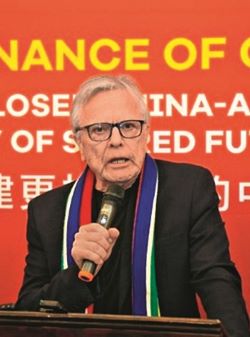|
||||||||||
| Home Top News Economy/Tech Culture/Sports China in Foreign Eyes Green Development Videos Intangible Cultural Heritages |
|
||||||||||
| Home Top News Economy/Tech Culture/Sports China in Foreign Eyes Green Development Videos Intangible Cultural Heritages |
| ChinAfrica |
| Long-Term Governance |
| China’s stability and long-term planning make it a sheet anchor amid global storm |
| By Xia Yuanyuan and Liu Ting | VOL. 17 August 2025 ·2025-07-24 |

Chinese-made lifeboats are loaded onto a ship bound for France at Qingdao Port, Shandong Province, on 5 April (VCG)
China is stepping up efforts to fulfil the targets set in the 14th Five-Year Plan (FYP) in its final year of implementation and to formulate the next FYP. Chinese President Xi Jinping called for adapting to changing situations, identifying strategic priorities, and making sound plans for the compilation of the 15th FYP (2026-2030) on April 30.
How will the next FYP maintain policy continuity while adapting to external challenges? What is the significance of China’s capacity to focus on long-term objectives in an era of unprecedented change? What innovative contributions does this long-termism offer to global development theory? Three experts share their views.
Strategic Blueprint for Stability and Innovation

Gert Grobler, Former South African Diplomat and Honorary Professor, Institute of African Studies, Zhejiang Normal University
FYPs have served as foundational blueprints for China’s national transformation. The 14th FYP (2021-2025) marks a critical pivot, emphasising technological self-reliance, domestic consumption via the “dual circulation” strategy, and a green, high-tech transition in response to external pressures. The upcoming 15th FYP is expected to consolidate these efforts and address structural challenges such as demographics. As adaptive instruments of strategic statecraft, these plans balance continuity with flexibility, blending central direction with local feedback to ensure long-term stability and competitiveness. They are key to understanding China’s trajectory and its evolving global role.
China’s capacity to focus on long-term objectives, institutionalised through its FYPs, is a significant strategic advantage. Over the decades, these plans have evolved from rigid directives into comprehensive frameworks guiding innovation and reform. Despite formidable external pressures - including trade restrictions and technological bans from the US and its allies - China retains a strong capacity to advance its ambitions. It leverages key assets such as its vast domestic market, rising innovation investment, and growing influence through the Belt and Road Initiative and BRICS. The current and forthcoming FYPs reflect this strategy by prioritising technological self-reliance and economic resilience to navigate a complex global landscape.
China’s meteoric rise on the global stage in recent decades has triggered debates over governance models. A frequently cited explanation for its sustained economic and strategic gains is its long-term governance approach, which stands in stark contrast to the short-term, election-driven political cycles of many Western governments. China’s ability to plan and implement long-term national strategies through centralised planning and leadership continuity offers notable advantages - particularly in areas requiring sustained focus, policy stability, and strategic development.

Visitors explore a Chinese new energy vehicle in Shanghai on 26 April (VCG)
A core strength of China’s governance model lies in its ability to craft and execute long-term strategies without the disruption of frequent political turnover. The FYPs, alongside broader development goals such as Made in China 2025, carbon neutrality by 2060, and the 2049 national rejuvenation vision, are products of a system designed for continuity and gradualism.
In contrast, Western governments often struggle with policy inconsistency due to election cycles, facing budgetary gridlock, fragmented decision-making, and political lobbying that can delay or dilute important public projects.
Western media criticism of China’s FYPs - which blend market dynamism with strategic coordination - is often rooted less in the plans themselves and more in deeper ideological discomfort with China’s constructive governance model. By portraying planning as inherently flawed or illegitimate, critics risk overlooking a key pillar of China’s economic success and strategic resilience. China’s FYPs have clearly proven to be adaptable, goal-oriented, and effective in navigating both domestic challenges and global shifts. A more balanced perspective from the West - based on facts rather than ideology - is essential for any meaningful dialogue on governance in the 21st century.
Policy Continuity as a Pillar of Resilience

Hisham El-Zimaity, Secretary General, Egyptian Council for Foreign Affairs and Former Ambassador of Egypt to Japan, Hungary, Slovenia and Pakistan
China’s FYPs offer strategic long-term vision with flexible execution. The phased approach allows for mid-course adjustments, ensuring adaptation to new technological, geopolitical and economic realities.
There is strong consistency in policy implementation. The FYP model ensures continuity, avoiding short-term political shifts that disrupt development - challenges often faced in systems with frequent leadership changes. This stability ensures that infrastructure, innovation and industrial policies remain on course, encouraging investment in long-term projects.
The model assumes a degree of relative stability, especially in the face of global shocks such as trade wars and geopolitical tensions, which require agile policymaking and coordinated responses.
It also promotes balanced economic and social development. Unlike economic models focused solely on GDP growth, China’s FYPs integrate social welfare, poverty alleviation, green energy and technological self-reliance. This approach has driven China’s rapid industrialisation while also addressing environmental and social concerns.
In an uncertain world, it exemplifies the value of long-term planning. China’s model highlights the benefits of structured, strategic thinking in an era of global economic instability. Countries facing deindustrialisation, energy transitions, and technological shifts can benefit from this kind of policymaking.
While not universally applicable, China’s FYP model, anchored in long-term strategic goals, infrastructure investment, and technological innovation, offers valuable insights for countries pursuing sustainable economic growth amid global uncertainty.
Governance Synergy Driving Sustainable Growth

Nasser Bouchiba, Chairman, Africa-China Cooperation Association for Development, Morocco
The FYP is a planning tool used by some countries to guide national development under state leadership. In China, these plans have always been a central lever of economic policy. Since 2006, they have been known as “five-year development plans,” reflecting the desire to harmonise state planning with market mechanisms.
The 14th FYP is defined by its strategic priorities: technological innovation, ecological transition and high-quality development. As a committed stakeholder in the China-Africa technology partnership, I am particularly interested in these guidelines as they offer a strong foundation for balanced and mutually beneficial cooperation with Africa.
During an exchange with a senior Chinese official on an official visit to Morocco, I asked about the practical modalities for implementing the FYP’s goals in a context where China’s economy is fully integrated into the global market. His answer was clear: under the leadership of the Communist Party of China, officials at all levels are not only mobilised to achieve the goals but are also encouraged to exceed them.
This strategy is based on a dynamic of continuous improvement, incorporating mechanisms for evaluation and adaptation. Its effectiveness stems above all from the coordination among all stakeholders, who work in synergy to achieve national objectives.
China’s FYP is no longer solely rooted in planned economy logic; it has become one of the world’s most effective governance models. The state plays a structuring role by equipping economic and social actors with the institutional tools they need to maximise their contributions to society, the economy and the environment.
This mechanism is undoubtedly central to China’s competitive advantage. It has enabled development on a scale unprecedented in modern history - development that President Xi Jinping has firmly oriented towards sustainability and inclusiveness.
| About Us | Contact Us | Advertise with Us | Subscribe |
| Copyright Beijing Review All rights reserved 京ICP备08005356号-5 京公网安备110102005860号 |